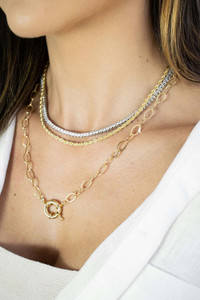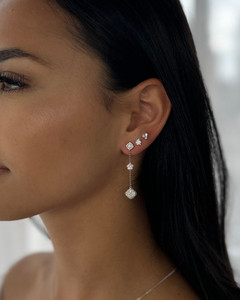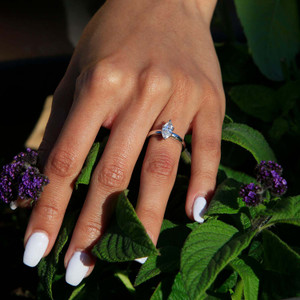Black Diamonds: A Deep Dive into Their Allure and Worth

In recent years, black diamonds have surged in popularity, captivating jewelry enthusiasts with their unique charm and mysterious appeal. These unconventional gems offer a striking alternative to traditional clear diamonds, making them an increasingly sought-after choice for those seeking distinctive jewelry pieces. Let's explore the fascinating world of black diamonds, from their origins and characteristics to their value and versatility in modern jewelry design.
The Essence of Black Diamonds
At their core, black diamonds are genuine diamonds composed of carbon, just like their colorless counterparts. However, what sets them apart is their opaque nature and high-luster appearance, resulting from numerous inclusions within the stone. These inclusions give black diamonds their characteristic dark hue, which can range from deep black to shades of dark green or brown. The metallic sheen often observed in black diamonds adds to their allure, creating a captivating interplay of light on their surface.
A Journey Through Time: The History of Black Diamonds
The discovery of natural black diamonds, initially termed "carbonados," dates back to around 1840 in Brazil. Despite their relatively recent discovery, these gems boast an ancient origin, having formed deep within the Earth between 2.6 to 3.8 billion years ago. Interestingly, black diamonds didn't gain significant traction in the jewelry world until the late 1990s. It was during this period that jewelers began to appreciate and showcase their bold, unique properties. This newfound interest also coincided with the emergence of laboratory-created black diamonds, offering a more accessible alternative to natural specimens.

The Versatility of Black Diamonds in Jewelry
Black diamonds have found their place in various jewelry applications, offering a contemporary twist to classic designs. Their versatility shines through in several ways:
- Black Diamond Rings: Perhaps the most popular application, black diamond rings make a bold statement. From solitaire settings to intricate designs incorporating multiple stones, these rings cater to diverse tastes.
- Black Diamond Wedding Bands: For couples seeking a unique symbol of their union, black diamond wedding bands offer a sophisticated and modern alternative to traditional bands.
- Black Diamond Engagement Rings: Unconventional brides-to-be are increasingly drawn to black diamond engagement rings, appreciating their distinctive appearance and symbolic depth.
- Black Diamond Wedding Ring Sets: Coordinated sets featuring black diamonds create a cohesive and striking look for couples who appreciate matching jewelry.
- Women's Black Diamond Rings: From cocktail rings to everyday wear, women's black diamond rings come in various styles to suit different occasions and preferences.
The Chromatic Mystery: How Black Diamonds Get Their Color
The dark hue of black diamonds is attributed to the presence of numerous mineral inclusions within the stone. These inclusions primarily consist of pyrite, hematite, and graphite – the same minerals found in white diamonds but in much higher concentrations. Additionally, the presence of fractures within the diamond, which may be stained to varying degrees, contributes to its overall dark appearance.
The intensity of a black diamond's color can vary significantly based on the quantity and distribution of these inclusions and fractures. Some stones may appear nearly colorless, while others exhibit deep, rich black tones or dark green hues. This variation in color intensity adds to the uniqueness of each black diamond, making them truly one-of-a-kind gems.
Assessing the Value of Black Diamonds
Natural black diamonds are among the rarer colored diamonds, which contributes to their desirability and value. Several factors influence the worth of a black diamond:
- Origin: Natural black diamonds typically command higher prices than their lab-created counterparts due to their rarity and the challenges associated with mining them.
- Unique Hue: The specific shade and intensity of a black diamond's color can impact its value, with some variations being more sought-after than others.
- Aesthetic Qualities: The overall appearance, including the stone's luster and any unique patterns formed by inclusions, can affect its desirability and price.
- Size and Shape: As with all diamonds, larger stones and certain popular shapes may fetch higher prices.
It's worth noting that the value of black diamonds can vary significantly based on individual preferences and market trends. Prospective buyers are encouraged to explore various options and consult with reputable jewelers to find the perfect stone that aligns with their taste and budget.

Shapes and Sizes: The Versatility of Black Diamonds
Like their colorless counterparts, black diamonds can be cut into a wide array of shapes to suit different jewelry designs and personal preferences. Common shapes include:
- Round: The classic and most popular diamond shape, offering maximum brilliance.
- Oval: An elegant elongated shape that can create the illusion of longer fingers when used in rings.
- Cushion: A square or rectangular shape with rounded corners, blending vintage charm with modern appeal.
- Princess: A square shape with sharp corners, popular for its contemporary look.
- Pear: A teardrop shape that combines the brilliance of a round cut with the elegance of a marquise.
- Emerald: A rectangular shape with step-cut facets, known for its sophisticated appearance.
- Marquise: An elongated shape with pointed ends, often used to create unique and eye-catching designs.
- Asscher: A square shape with cropped corners, similar to an emerald cut but with a more vintage flair.
- Radiant: A square or rectangular shape with trimmed corners, combining the brilliance of a round cut with the elegant lines of an emerald cut.
- Heart: A romantic shape perfect for symbolic jewelry pieces.
Black diamonds are available in various carat weights, though it's important to note that due to their high inclusion content, they may have slightly different density compared to colorless diamonds of the same size.

Types of Black Diamonds: Natural, Lab-Grown, and Treated
When shopping for black diamonds, consumers typically encounter three main categories:
- Natural Black Diamonds: Also known as "fancy black" diamonds, these gems are formed naturally in the Earth and owe their color to high concentrations of mineral inclusions, particularly graphite.
- Lab-Grown Black Diamonds: Created in controlled laboratory environments using high-temperature technology to crystallize carbon, these diamonds share the same physical and chemical properties as natural black diamonds. They offer a more accessible and environmentally friendly alternative to mined stones.
- Treated Black Diamonds: These start as heavily included white diamonds unsuitable for jewelry in their original state. Through irradiation or heat treatments, these diamonds are transformed to achieve a black color.
Each type has its own merits, and the choice often comes down to personal preference, budget, and ethical considerations.

Grading and Certification of Black Diamonds
Unlike colorless diamonds, which are graded based on the traditional 4Cs (cut, color, clarity, and carat), black diamonds require a different approach due to their opaque nature. The Gemological Institute of America (GIA) classifies them as "fancy black" diamonds and evaluates them using scales designed for colored diamonds. These assessments focus on:
- Color Intensity: The depth and richness of the black hue.
- Tone: The lightness or darkness of the color.
- Saturation: The purity and strength of the color.
While black diamonds may not come with the same detailed certifications as colorless diamonds, reputable sellers often provide documentation outlining the stone's unique specifications and grading information.
Caring for Black Diamond Jewelry
While black diamonds are durable, their high inclusion content can make them more susceptible to chipping or breaking if subjected to strong impacts. To maintain the beauty of black diamond jewelry:
- Clean regularly using a soft brush and mild soap solution.
- Avoid exposing the jewelry to harsh chemicals or extreme temperature changes.
- Store black diamond pieces separately to prevent scratching from other jewelry items.
- Have the settings checked periodically by a professional jeweler to ensure the stones remain secure.
Embracing the Allure of Black Diamonds
Whether you're drawn to a striking black diamond ring, considering a unique black diamond wedding band, or exploring options for a one-of-a-kind black diamond engagement ring, these captivating gems offer a world of possibilities. Their deep, mysterious hue and brilliant luster make them an excellent choice for those seeking to make a bold statement with their jewelry.
As you embark on your journey to find the perfect black diamond piece, remember that each stone tells its own story. Whether you opt for a natural black diamond with its billions of years of history or choose a lab-grown alternative that reflects modern technological advancements, you're investing in a truly remarkable gem.
From classic solitaire settings to intricate designs that incorporate black diamonds alongside other gemstones, the versatility of these dark beauties knows no bounds. Whether you're in the market for black diamond wedding rings to symbolize your union or searching for the ideal women's black diamond ring to add to your collection, take the time to explore the myriad options available.
In conclusion, black diamonds offer a unique blend of mystery, elegance, and contemporary style. As their popularity continues to grow, these enigmatic gems are carving out their own niche in the world of fine jewelry, appealing to those who dare to be different and appreciate the beauty of the unconventional. Whether you're drawn to their deep, mesmerizing color or the symbolism of their strength and resilience, black diamonds provide a compelling alternative to traditional colorless diamonds, ensuring your jewelry stands out from the crowd.





